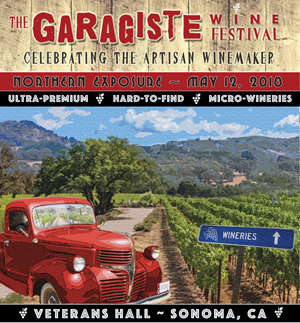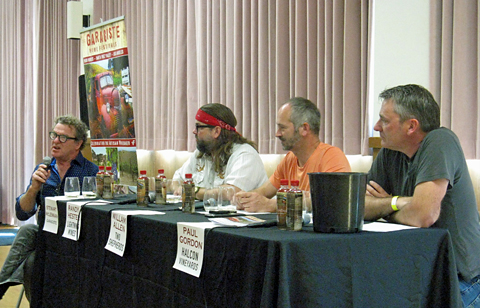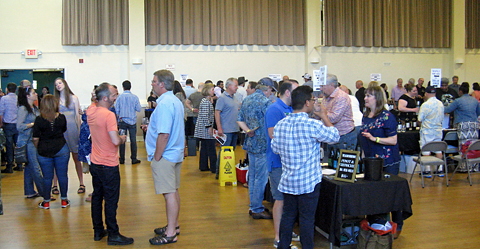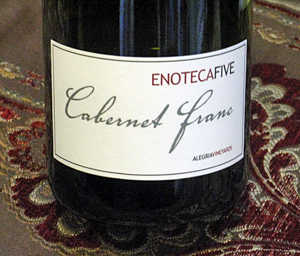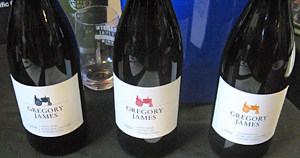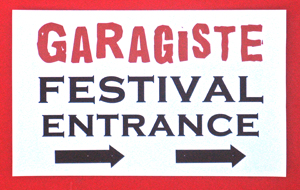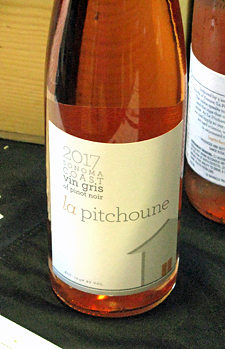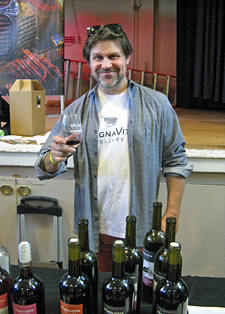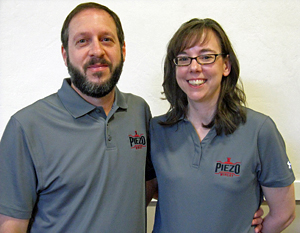Betwixt Wine
Betwixt is the project of Tim Telli, who makes his wines in San Francisco. He focuses on Chardonnay, Pinot Noir, and Rhône grape varieties, and his fruit comes from many growing regions – Anderson Valley, Sonoma Mountain, Chalone, Santa Cruz Mountains, and Mokelumne River-Lodi. The first Betwixt wines were from the 2012 vintage. (Disclosure – I’ve helped bottle some of the Betwixt wines) Tim poured a couple of wines that I thought were particular standouts. The 2015 Helluva Vineyard Pinot Noir, from Anderson Valley, displayed classic regional character with red fruit, tea leaf, mushroom / forest floor, and floral notes, with fine acidity and moderate tannins on the finish. Even better was the 2016 Boer Vineyard Grenache, from the Chalone AVA in Monterey County. Fermented with 25% whole clusters, this was savory and spicy, with strawberry and cherry fruit and earth in support, plus good structure and chalky tannins – this should develop well with a few years in the cellar.
Camlow Cellars
Camlow is a fairly new venture, and the label’s Craig Strehlow and Alan Campbell were behind their winery table to pour their most recent releases. Craig makes the wines, and he was the longtime vineyard manager and winemaker for Keefer Ranch. Alan owns the four-acre Magna Porcum Vineyard near Graton, in Green Valley of Russian River Valley. The vines there were planted in 2006, and 2012 was the first vintage for Camlow. The 2017 “Sus Volans” Whole Cluster Pinot Noir Rosé, made entirely in stainless steel with no malolactic fermentation, was very pleasant, with red fruit, flowers, and fresh herbs on the nose, with a lively mouthfeel and finish. I tasted three vintages of the Camlow “Magna Porcum” Pinot, and my favorite was the 2014 “Magna Porcum” Estate Pinot Noir – this featured black cherry, plum, and earth aromas, with hints of spice and vanilla, good structure and moderate tannins.
Carini Wines
Carini was established in 2000, but the label is not well-known due both to its small production and its location in the remote town of Hayfork in Trinity County, in the far northern part of California. Andrew Carini and his wife Shawnee are the proprietors, and they purchase fruit from a variety of locations, including Napa, Sonoma, Santa Cruz Mountains, Sierra Foothills, as well as Trinity County. Andrew was on hand to pour his wines at the event. The 2014 “Dubakella” Hyampom Grel Ranch Vineyard Zinfandel from Trinity County had bright raspberry fruit, herbs, and hints of pepper and flowers, medium-light weight with a moderately tannic finish – quite distinctive. Another notable wine was the 2014 “Howell & Cruz” – 50% Cabernet Sauvignon from the Santa Cruz Mountains and 50% Merlot from Howell Mountain. Subtle darker fruit, earth, spice, and a touch of mocha, with plenty of structure and grippy, youthful tannins – worth cellaring this for awhile.
Cutruzzola Vineyards
 |
Frank Cutruzzola and Lisa Miller are the proprietors of Cutruzzola Vineyards. Their estate Riven Rock Vineyard is one of the cooler-climate vineyard sites in California, just a few miles from the coast near Cambria in San Luis Obispo County. The site was planted in 2001 and 2006 to Riesling and Pinot Noir, and noted Central Coast vintner Stephen Dooley of Stephen Ross Cellars makes the Cutruzzola wines. Frank started me with the 2015 Riven Rock Estate Riesling, made in a dry style and displaying bright stone fruit, petrol, with floral and stony mineral undertones, vibrant acidity and medium weight on the palate and a long finish. The 2012 Riven Rock Estate Riesling was quite different but still nice, off-dry with noticeable sweetness on the finish but with a bigger petrol component on the nose plus plenty of stone fruit and flowers. Cutruzzola makes a couple of Pinot bottlings and my favorite at this tasting was the 2013 “Gloria” Riven Rock Estate Pinot Noir, with subtle cherry fruit, herbs, and touches of earth and spice, with lighter body and a lively texture and finish.
Enoteca Five
Enoteca Five is a small family winery based in Livermore, and winemaker Michael Chalkley poured his wines at the tasting. The label’s first vintage was 2010, and fruit has come from various locations including Lodi, Carneros, Russian River Valley, and Livermore Valley. I thought the standout wine from Enoteca Five was their 2011 Alegría Vineyards Cabernet Franc, from the northern part of Russian River Valley. Black cherry and earth aromas plus the distinctive and intriguing jalapeño note I’ve found in several other Cab Francs from this vineyard. A lighter style with good acidity, lively texture, and moderate tannins on the finish. Also noteworthy was the 2013 Merlot from the Napa Valley side of Carneros, with upfront cherry and spice plus earthy and herbal notes in the background, along with medium body and a firm tannic finish.
Fallon Place Wine
Fallon Place is the project of Cory Michal. He makes his wines in San Francisco and sources fruit from several Sonoma County growing regions – Sonoma Valley, Carneros, Sonoma Coast, and Chalk Hill. The label’s first vintage came in 2014. My favorite of the Fallon Place wines was the 2016 Herbitage Vineyard Pinot Noir from Carneros. From 2A clone, this had pretty floral aromas along with earthy and herbal red fruit, and a lively mouthfeel and finish.
Fields Family Wines
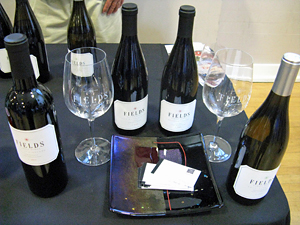 |
Owner Russ Fields purchased property in the Mokelumne River AVA of Lodi in 2005, and the winery’s estate vineyard includes Syrah, Mourvèdre, Tempranillo, Grenache Blanc, and Vermentino. Direct-to-Consumer manager Michael Perry poured the wines at the tasting. All of the Fields Family wines I tasted were sourced from Lodi fruit. The 2016 Delu Vineyard Grenache Blanc spent seven months in neutral oak, and did not go through malolactic fermentation – it displayed pear, spice, and floral notes with a pleasant mouthfeel and finish. A particular highlight was the 2016 Bechthold Vineyard Cinsault, from 125+ year-old vines that may be the oldest Cinsault vines in the world. Bright and savory red fruit, with medium-light weight on the palate, great acidity, and a clean finish. The 2016 “100% Whole Cluster Syrah,” made by partial carbonic fermentation, featured bright black cherry and herbal aromas, lighter body with fine acidity and a tasty finish – a nice easy-drinking young Syrah.
Gregory James Wines
Gregory James is a fairly new winery established by two friends – noted viticulturist Greg Adams and construction site developer Jim Demuth. Greg is familiar to many in Sonoma County, as he’s worked with many notable wineries, and he’s currently also the viticulturist and winemaker for Baker Lane. The first Gregory James wines were from the 2013 vintage, and they work exclusively with vineyards in the West Sonoma Coast region. The 2014 Hawk Hill Vineyard Chardonnay was one of my favorite Chardonnays of the tasting, featuring stone fruit, flowers, earth, and spice aromas, fine acidity, and a bright, fresh finish. The 2014 Hawk Hill Pinot Noir was another standout – intense black cherry fruit, tea leaf, flowers, and a stony mineral note, with a fairly structured mouthfeel and refined tannins. Tasty now but this should develop for awhile in the cellar too.
Halcón Vineyards
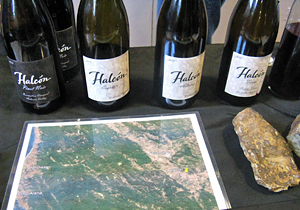 |
Halcón proprietors Paul and Jackie Gordon were on hand at the tasting. Their vineyard, in the Yorkville Highlands area of Mendocino County, is planted mostly to Syrah, with some Grenache, Mourvèdre, and a little Viognier. Their first vintage came in 2009, and Paul has worked with Scott Shapley in San Francisco to make the wines. (Disclosure – I’ve helped bottle some of the Halcón wines) All of the wines I tasted were fermented with 50% whole clusters. The 2016 Bearwallow Vineyard Pinot Noir, from a site in the Deep End of Anderson Valley, was one of my favorite Pinots of the day, featuring bright cherry, tea leaf, flowers, and earth on the nose, with a lively texture and fine tannins. A barrel sample of 2017 Estate Mourvèdre that was poured at the seminar was another standout. Herbal red fruits, smoky, peppery, and floral, with notes of iron and game, a bright mouthfeel and fine tannins. The 2016 “Alturas” Estate Syrah, co-fermented with 3% Viognier, showed bright blackberry fruit, herbs, pepper, and a hint of flowers, with a medium-weight mouthfeel and firm tannic finish – needs time but promising. Another wine poured at the seminar was the 2016 Theopolis Vineyard Petite Sirah – this had intense black pepper aromas with dark berry fruit, flowers, and earth, a rich yet lively mouthfeel and big, chewy tannins.
Kendric Vineyards
Stewart Johnson is the proprietor of Kendric, and his estate vineyard, on the northern edge of Marin County and within the new Petaluma Gap AVA, is planted mostly to Pinot Noir, along with a small block of Viognier. His family also has a vineyard in Amador County’s Shenandoah Valley, where they grow mostly Sangiovese. The first Kendric vintage came in 2004. (Disclosure – I’ve helped bottle some of the Kendric wines) I’ve tasted most of the Kendric Viogniers over the years, and I think the 2017 Estate Viognier may well be the best yet. It combined beautiful floral, citrus, and stone fruit aromatics with fine acidity and a slightly chalky texture (from spending about six hours on the skins before pressing). Stewart also poured a pre-release preview of the 2016 Estate Pinot Noir – fermented entirely with whole clusters, it displayed bright herbal, floral, and red-fruited aromas with a lively structure and moderate, refined tannins.
|
La Pitchoune Winery
La Pitchoune is a fairly new venture run by Tracy Nielsen and Peter Joachim Nielsen. The first vintage was from 2012 and the wines are made by Andrew Berge, who is also the winemaker for Spell Estate. Most of the fruit for the La Pitchoune wines comes from the Sonoma Coast, Russian River Valley, and Sonoma Mountain. The 2017 Vin Gris of Pinot Noir, from the Sonoma Coast, was a standout, my favorite vin gris or rosé wines of the tasting – intense strawberry, floral, and spice aromas with a vibrant mouthfeel and finish. The 2014 Sonoma Coast Pinot Noir was also nice, with earth and forest floor notes upfront and black cherry and spice with a touch of vanilla in support, good structure and fine tannins.
Lightning Wines
 |
Randy and Brooke Hester are the proprietors of Lightning Wines. 2011 was the first Lightning vintage, and Grenache has been a specialty. Reds are generally fermented with about 30% whole clusters in open-top puncheons and aged in mostly older oak. Randy was on hand to pour his wines at the event. The 2015 “CdP Blanc” is a Grenache Blanc-based white – also including Picpoul and Marsanne, and all picked the same day and cofermented – that was poured at the seminar. Green apple and citrus aromas along with savory herbal notes, with a moderately rich texture but clean, fresh finish. The 2014 Fore Family Vineyard Grenache, from Lake County, was another seminar wine, and this featured ripe red fruits, herbs, flowers, and spice on the nose, with plenty of structure and fairly grippy tannins. Also noteworthy was the 2014 “Cease & Desist” (long story, but Lightning came out on the right end of things and avoided litigation) is about 85% Grenache along with Syrah, Mourvèdre, Cinsault, and Counoise. Showing ripe plum and earth plus hints of flowers and herbs, it had bright acidity and a moderately tannic finish.
MagnaVita Cellars
Ron Phillips is behind the MagnaVita label, and he makes his wines in Napa Valley. One of the newest wineries at the Garagiste event, MagnaVita sources fruit from El Dorado County as well as from Lodi and Livermore Valley. Ron poured two interesting Rosatos, one from Tannat (the first Tannat I’ve had made in this style!) and another from Lagrein. I preferred the 2017 Lone Pine Vineyard Rosato di Lagrein, from El Dorado County – this had floral and red berry fruit aromas, with vibrant acidity and a fresh finish. Another noteworthy wine from the Sierra Foothills was the 2016 “Brothers Red Blend,“ a Lagrein-based blend that also includes Refosco and a little Merlot. Earth, flowers, darker fruit, and spice on the nose, with plenty of structure and fairly grippy youthful tannins.
Montagne Russe
 |
Montagne Russe is the label of Kevin Berofsky, who focuses on Chardonnay, Pinot Noir, and Syrah, sourced from cooler-climate growing regions. Kevin made his first wines about ten years ago and currently produces them in San Francisco. (Disclosure – I’ve helped bottle some of the Montagne Russe wines) I tasted Chardonnay, Pinot Noir, and Syrah from Montagne Russe, and found one of each that I thought was particularly noteworthy. The 2015 “Dragon’s Back” Chardonnay comes from Black Knight Vineyard in the Petaluma Gap. Made in neutral oak, it displayed citrus, flowers, and earth on the nose along with a bright, fresh mouthfeel and finish. From the same vineyard source, the 2016 “Dragon’s Back” Pinot Noir had aromas of red fruits, savory herbs, mushrooms, and spice, with medium weight on the palate and moderate tannins. The 2016 Alder Springs Vineyard Syrah, from far northern Mendocino County, was savory and earthy, with bold dark berry fruit, spice, plus notes of pepper and vanilla, a structured mouthfeel and firm tannins – needs time but shows lots of potential.
Murder Ridge Winery
Murder Ridge proprietors Leslie Sisneros and Steve Alden welcomed me to their table at the tasting. Leslie has been the winemaker for several noted Sonoma County producers over the years, while Steve owns Perli Vineyard in the remote Mendocino Ridge AVA between Anderson Valley and the Pacific coast. I had tasted most of the current Murder Ridge wines at another recent tasting, and tried just one at the Garagiste event. This was a new bottling, the 2016 Perli & Gianoli Vineyards Pinot Noir, one of three new 2016 Pinots that the winery will release. Featuring bright and savory aromas along with cherry, spice, and tea leaf notes plus floral undertones, this had very good structure and a long, lively finish, one of the day’s best Pinot Noirs.
Piezo Winery
Winemaker Atsmon Shahar and his wife Laura run the Piezo label. The first vintage came in 2015, and they work with a number of grape varieties, sourcing from Sonoma and Mendocino counties. Both Atsmon and Laura were behind their winery table and they poured me several of their current releases. The 2016 Black Knight Vineyard Chardonnay was sourced from a noted Petaluma Gap site, and featured bright pear, citrus, and spice aromas, with medium weight on the palate and a fairly lively finish. The 2016 Black Knight Vineyard Pinot Noir was also good, with black cherry, earth, and savory herbal notes, nice acidity and a long finish. The 2015 Antonina’s Vineyard Cabernet Franc, from the Fountaingrove area, showed herbs and darker berry fruit, with spice and floral undertones – lively but a bit rough, this may round out with more time.
St. Romedius
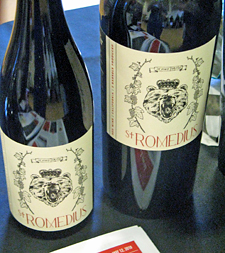 |
Robert and Milli Pintacsi are the proprietors of St. Romedius, and they established the label in 2015. Robert makes the wine in Napa, and just one wine has produced by St. Romedius thus far, with fruit sourced from the recently-approved Lamorinda AVA just over the hills to the east of Oakland and Berkeley. Robert poured me their first release, a NV Red Wine that’s mostly from the 2015 vintage – it’s a field blend of Petite Sirah, Syrah, and Zinfandel, aged in one-year old and older barrels. This had aromas of darker berry fruit, chocolate, and vanilla/oak, with a fairly rich mouthfeel and finish. I also tasted a barrel sample of the 2016 Red Wine – another field blend from the same vineyard and same grape varieties as the first wine. This had a larger proportion of Syrah, was aged in 33% new French oak, and will be bottled about a month after the tasting. Interestingly, this wine had noticeably less oak influence, with brighter and more herbal notes on the nose – I preferred this one of the two.
T. Berkley Wines
 |
Winemaker Taylor Boydstun launched his T. Berkley label in 2016, inspired by Chenin Blanc and Cabernet Franc from the Loire Valley. Although the label is new, Taylor has worked at wineries in California, Australia, New Zealand, and Austria for nearly ten years. He sources fruit from Sonoma, Napa, and Mendocino county vineyards and makes the wine in Sebastopol. I thought two of the T. Berkley wines were particularly noteworthy. The 2016 Côt (the name for Malbec in the Loire Valley and other parts of France) was sourced from a vineyard the Yorkville Highlands and made entirely in stainless steel. Plenty of upfront dark fruit, plus spice and a bit pepper, this had very good structure and acidity, finishing with fine tannins. Also quite nice was the 2016 Chenin Blanc, from older vines grown in the Ukiah Valley. Pressed after one day of skin contact and fermented in neutral oak and stainless steel, this displayed herbal stone fruit aromas, with touches of spice and flowers, medium weight on the palate, and a lively finish.
Two Shepherds
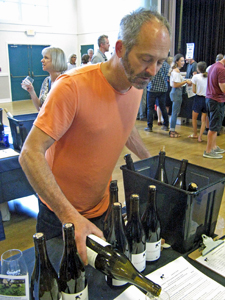 |
William Allen is the Two Shepherds owner/winemaker, and he focuses mainly on wines made from Rhône grape varieties. The wines are made in Sonoma County, and the first commercial vintage was in 2010. William poured several noteworthy wines at the event. The 2016 Delu Vineyard Vermentino from Lodi was made in neutral oak and stainless steel, and had citrus, petrol, and floral notes on the nose, with a bright mouthfeel and finish. The 2015 “Pastoral Blanc” blend from Russian River Valley was featured at the seminar, and is a blend of 50% Roussanne along with Marsanne, Viognier, and Grenache Blanc. Herbs, orangepeel, flowers, and a slight saline note along with stone fruit and citrus, medium-bodied with a tasty finish, one of the better white wines of the day. The 2015 Trimble Vineyard Carignan from Mendocino was peppery and spicy, with bright red fruit and earth, and good structure with moderate tannins. Another seminar wine, the 2015 Bechthold Vineyard Cinsault from Lodi, fermented with 100% whole clusters, featured subtle black cherry fruit, herbs, earth, pepper, and a stony mineral note, with chalky tannins on the finish.
Von Holt Cellars
This is the label of former Secret Service agent Chris Von Holt and his wife Pamela. The first vintage of their wines was in 2008, and the focus has been mainly on cooler-climate Chardonnay, Pinot Noir, and Syrah from the Sonoma Coast and Russian River Valley, though they’ve made wines from a few other varieties and other growing regions as well. John Fones is the winemaker for Von Holt, and the wines are produced in San Francisco. (Disclosure – I’ve helped bottle some of the Von Holt wines) Chris was on hand to pour his wines at the tasting, and started me out with the 2014 Heintz Vineyard Chardonnay, from a noted Sonoma Coast site. This displayed bright citrus and apple fruit, spice, flowers, and earth on the nose, with medium weight and a long, lively finish. One of the day’s best Pinots was the 2014 Suacci Vineyard Pinot Noir, also from the Sonoma Coast. Aromas of strawberry and cranberry, flowers, earth, and a touch of spice, with vibrant acidity and a bright mouthfeel and finish – tasty now but this should develop further with more time in the cellar.
|


